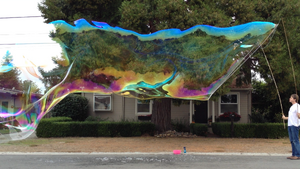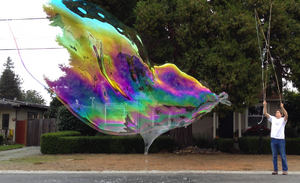m (→Mixing: separate two steps to make directions clearer) |
m (→INGREDIENTS: add zero in front of numbers that start with a decimal) |
||
| (2 intermediate revisions by 2 users not shown) | |||
| Line 8: | Line 8: | ||
I also refer to this mix as HECWSR since I usually make it with WSR301. But you can use J-Lube just as well. |
I also refer to this mix as HECWSR since I usually make it with WSR301. But you can use J-Lube just as well. |
||
| + | |||
| + | '''Equipment''' (used in photos): Modular loop with 100" Rubbermaid Webfoot Microfiber top-string and a bottom-string (210"-220" long) made from a single strand of deconstructed Rubbermaid rayon mop yarn. See [[Mop Heads]]. |
||
==INGREDIENTS== |
==INGREDIENTS== |
||
*Polymer powder mix: |
*Polymer powder mix: |
||
| − | **.42 grams "degraded" WSR301. With potent WSR301, use 1/4 to 1/3 this amount. |
+ | **0.42 grams "degraded" WSR301. With potent WSR301, use 1/4 to 1/3 this amount. |
**7 grams Natrosol 250HR |
**7 grams Natrosol 250HR |
||
*3650 grams water measured into a 1 gallon jug that will store the juice |
*3650 grams water measured into a 1 gallon jug that will store the juice |
||
| Line 19: | Line 21: | ||
==='''SUBSTITUTIONS'''=== |
==='''SUBSTITUTIONS'''=== |
||
| − | '''J-Lube substitution. '''If using J-Lube, use 4 times the amount specified (1.7 grams of 'degraded' j-lube or .4 - .6 grams of potent J-Lube). |
+ | '''J-Lube substitution. '''If using J-Lube, use 4 times the amount specified (1.7 grams of 'degraded' j-lube or 0.4 - 0.6 grams of potent J-Lube). |
'''HEC substitution'''. If using a higher viscosity HEC such as Natrosol 250 HHR or Dow Cellosize QP100MH, use a little less than specified. My guess 6 grams. |
'''HEC substitution'''. If using a higher viscosity HEC such as Natrosol 250 HHR or Dow Cellosize QP100MH, use a little less than specified. My guess 6 grams. |
||
| Line 52: | Line 54: | ||
[[Category:HEC]] |
[[Category:HEC]] |
||
[[Category:PEO]] |
[[Category:PEO]] |
||
| + | [[Category:For Index]] |
||
Latest revision as of 22:53, 1 January 2019


First brewed on 2012 11 01. This is an HEC-based mix with a little bit of PEO. I developed this recipe after I had a really great session where I added a bit of eGoo dregs to the last bit of HEC-juice that I was testing one day (2012/10/30). This mix was my best guess as to what might have been in the ad hoc mix that worked so well on 2012/10/30.
This makes nice long tubes and can make super giants as well.
The amounts were chosen based on the capacity of the jugs that I use. They are nominally 1 gallon jugs but hold a bit more.
The water:detergent ratios is 20.3:1. 20:1-21:1 seems to work well for HEC-based mixes. The higher-dilutions that I like with PEO and guar-based juice do not seem to work as well with HEC.
I also refer to this mix as HECWSR since I usually make it with WSR301. But you can use J-Lube just as well.
Equipment (used in photos): Modular loop with 100" Rubbermaid Webfoot Microfiber top-string and a bottom-string (210"-220" long) made from a single strand of deconstructed Rubbermaid rayon mop yarn. See Mop Heads.
INGREDIENTS[]
- Polymer powder mix:
- 0.42 grams "degraded" WSR301. With potent WSR301, use 1/4 to 1/3 this amount.
- 7 grams Natrosol 250HR
- 3650 grams water measured into a 1 gallon jug that will store the juice
- 4 grams baking soda
- 180 grams Dawn Pro
- 2 grams citric acid
SUBSTITUTIONS[]
J-Lube substitution. If using J-Lube, use 4 times the amount specified (1.7 grams of 'degraded' j-lube or 0.4 - 0.6 grams of potent J-Lube).
HEC substitution. If using a higher viscosity HEC such as Natrosol 250 HHR or Dow Cellosize QP100MH, use a little less than specified. My guess 6 grams.
Mixing[]
Preparation
- pour 300 grams water (from jug) into a 1 liter measuring cup
- heat 500 grams water (from jug) in the microwave till quite hot (2 minutes or so)
Mixing
- start stirring the 300 ml of room temp water and add the powder bit by bit, making sure that it is well-dispersed with no clumping. (You could add the powder to dry alcohol or glycerine or propylene glycol to make a slurry and add the slurry, too. The HEC works as an effective dispersent for the PEO; so, a slurry isn't necessary as long as you are using an HEC that is cold-water dispersible)
- continue stirring and add the 500 grams hot water
- add baking soda while continuing to stir
- continue stirring for a couple of minutes. The mix should become quite viscous shortly after the baking soda is added
- stir for 30 seconds every several minutes until the mixture is near room temperature.
- NOTE! Even though the HEC may seem to have dissolved, it takes a while to fully hydrate. It may settle out into a gel layer if you do not periodically stir during the 20 to 30 minutes during which the water cools which is also the period during which the HEC hydrates.
- add more water from the jug to fill the measuring cup
- return the mixture to the jug.
- Turn the jug end-over-end several times.
- add the Dawn Pro
- add the citric acid
- Turn the jug end-over-end several times.